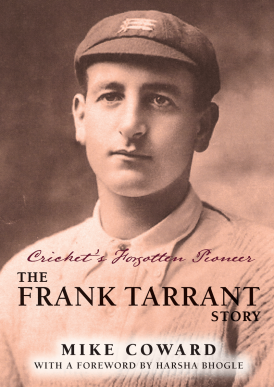Cricket’s Forgotten Pioneer: The Frank Tarrant Story
Archie Mac |Published: 2020
Pages: 104
Author: Coward, Mike
Publisher: The Cricket Publishing Company
Rating: 4.5 stars

The only disappointment with this book is the number of pages. At just 104, even with a smallish font, you have to wonder if there was more information to be had in relation to the subject. Perhaps I am looking at this wrong, after all Mark Twain famously said, “I didn’t have time to write a short letter, so I wrote a long one instead.”
The quality Mike Coward has achieved in 104 folios, which includes 23 pages of stats, is far superior to some of the modern Australian biographies that have numbered 600-800 pages. Beautifully written, Cricket’s Forgotten Pioneer is a pleasure to peruse.
The book is about Frank Tarrant and as the title suggests he is largely forgotten. Apart from his organising an Australian team to tour India in 1936, I must admit to not knowing a great deal about him. This is probably because he never played Test cricket, although his performances at first class level confirm he had the talent.
Tarrant was born into a cricket mad family, and one of his great uncles was George ‘Tear’em’ Tarrant, a feared fast bowler in England before the dawn of Test cricket. Interestingly Frank Tarrant, like his famous uncle, was a right arm bowler, however his cricket loving father was a devotee of left arm spin. So with his right arm tied at his side, the young Tarrant learnt to bowl with his opposite arm.
It seems Tarrant was a victim of Anglo Australian cricketing politics. He had left Australian for England as a young man. He turned up at Lord’s with a recommendation letter from Pelham Warner (‘Plum’ was not a knight at this stage), and a lot of confidence. After qualifying he became one of the best all rounders in the country, with his sure batting and left arm spinners. England chose not to select him for a Test as he was born in Australia, and his home country would not select him at international level as he played the majority of his cricket in England.
Tarrant indicated that although he enjoyed his cricket career he never made money from it. Tarrant eventually, with this time a recommendation from the famous cricketer and Indian prince, Ranji, travelled to India as a cricket coach to a couple of Maraharajahs. As a sideline he began importing horses, mainly from Australia, for his rich benefactors. The importing of equines made Tarrant a rich man.
His association with the Maraharajah of Patiala explains why Tarrant was instrumental in organising the first tour of an Australian team to India. The chapter that covers the prelude and actual tour is cricket writing at its very best. The Australian Cricket Board of Control for International Cricket (now CA), come across as churlish and myopic in their views to both Tarrant and Indian cricket. They treat Tarrant with distain and suspicion. To his credit Tarrant, who although perturbed, would not accept no for an answer and eventually, after a long wait, managed to organise a team. Unfortunately the Board still made things difficult and would not approve three quality players, in Bill Ponsford, Bill Woodfull or Alan Kippax, despite all three having retired form first class cricket. Notwithstanding the Board’s petulant restrictions, the team performed above expectations and was an outstanding success.
Coward relates all the above facts, not just concisely but also entertainingly. This is a book that should not be missed and is highly recommended.






Leave a comment